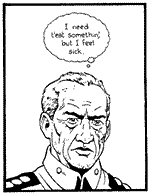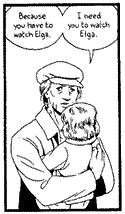>> Comment: Appointments With Disappointment
>> Comment: Accentuate The Positive?
More...

 Writer/Artist: Jason Lutes
Writer/Artist: Jason Lutes
Collecting BERLIN #1-8
Price: $15.95
Publisher: Drawn & Quarterly
ISBN: 1-896597-29-7
BERLIN is both the story of a city - a pile of stones - and a comprehensive biography - an amassing of private moments. The city itself is as much a character as any walking talking individual appearing within the pages of Jason Lutes exhaustive masterpiece.
Leaving the city of Koln by train, Marthe Muller bumps into journalist Kurt Severing. He lightens their dull journey to Berlin. One is returning as to a loving, but often harsh mother, while the other is discarding the parental influence for daunting pastures new. The year is 1928, and the city is facing massive social and political change.
Arriving in Berlin, the duo part company for their respective lives; Marthe has come to study as an artist and Kurt is there to complete his report on Germany's secretive attempts to reinstate its air-force. As they become just another part of a larger story, their burgeoning romance develops slowly over the course of the next 209 pages.
From here, the strata of German society spread out in front of them, from the Houdini-loving son of the German Jewish family to the foppish upper-class artists so caught up in the rules that they are unable to see the art. In this book collecting the first eight issues of BERLIN, the intertwining narratives come fully to the fore. The only thing that binds these disparate threads together is the city itself.
 Shifting from the close encounters of political discussions, artistic ideologies and confused passion to dispassionate bird's-eye views gives the impression that it's the city that is telling this story. It almost seems as though the only individual that could possibly understand how these incongruent lives could so effortlessly slot together is the city of Berlin itself.
Shifting from the close encounters of political discussions, artistic ideologies and confused passion to dispassionate bird's-eye views gives the impression that it's the city that is telling this story. It almost seems as though the only individual that could possibly understand how these incongruent lives could so effortlessly slot together is the city of Berlin itself.
While Lutes displays his effortless structural draftsmanship with these sweeping vistas of Germany's capital, he is equally skilled at the subtext-heavy close-ups. Eschewing the backgrounds for the talking heads segments focuses the eye on Lutes' strict lines and almost iconic displays of hidden meaning.
It is only during the first passionate grasp between Marthe and Kurt that the artwork loses it's trademark integrity and becomes pure iconography. This doesn't mean that Lutes was otherwise comfortable to sit back and let others innovate; the entire collection is filled with fascinating uses of panel structure. The most obvious is his integration of sound effects into the images as if they were part of the landscape itself.
A work such as this could easily have digressed into a political diatribe on what went wrong with Berlin and Germany prior to the Second World War, which would make it very dry and propaganda-driven, but Lutes dodges this potential problem effortlessly. While each of the characters has some loose connection to the political movements building in the city, none of them are given the opportunity to get on their soapbox, and thus they avoid being reduced to mouthpieces or ciphers.
Indeed, most of the characters find the entire situation rather distracting. Kurt becomes increasingly disenfranchised with politics as a whole, even as he watches his old friend Immenthaler become more focused on his political goals. Marthe is portrayed as a woman who knows little and cares less about the events unfolding around her.
It's the character of Gudrun that most cleverly delivers the political message. Hers is the tale of a single mother who falls into Communism not because of her political views, but because the Communists are the only people willing to help her out during a bad phase of her life.
 The flashback to the end of World War One demonstrates Lutes' disdain for war and his general incomprehension of its absurdity. That civilians under fire would rather risk being shot than walk across palace lawns is endemic of upper-class short-sightedness. Both the Communists and the burgeoning Nazi front are portrayed as groups composed solely of the working class, with the upper class remaining aloof or uncaring.
The flashback to the end of World War One demonstrates Lutes' disdain for war and his general incomprehension of its absurdity. That civilians under fire would rather risk being shot than walk across palace lawns is endemic of upper-class short-sightedness. Both the Communists and the burgeoning Nazi front are portrayed as groups composed solely of the working class, with the upper class remaining aloof or uncaring.
While BERLIN sets out to cover a broad cross-section of Berlin society, it never feels as though its characters are getting short shrift. A lot of the changes in their lives occur off-panel - for example, Gudrun leaves her husband, moves out, and finds a job, and we only ever see her after these events occur - yet the collection always has time to stop for quiet character moments. In one particularly poignant scene, a young Jewish boy exchanges a story of Houdini for a poster of the same from a travelling salesman.
As Lutes will readily admit, BERLIN is an epic undertaking. Planned as twenty-five issues, to be collected in three two-hundred page collections, his work will attempt to document a city under immense stress. He didn't visit the city until he was close to completing the issues collected in this first collection, but his depiction of the city is so convincing that this fact serves only as a testament to his depth of research and the genius of his architectural imagination.
Acclaimed by Time Magazine as one of the top five comic books published in 2000, BERLIN is already making great waves, even though it is only one-third complete. (This first volume can be enjoyed on its own, however, and issue nine will be reaching comic stores soon.) While BERLIN bears all the hallmarks of Lutes' previous work in JAR OF FOOLS, the scope of this undertaking will only grow with time. BERLIN: CITY OF STONES is a work that should not be missed by anyone who appreciates what comics are truly capable of.

This article is Ideological Freeware. The author grants permission for its reproduction and redistribution by private individuals on condition that the author and source of the article are clearly shown, no charge is made, and the whole article is reproduced intact, including this notice.


